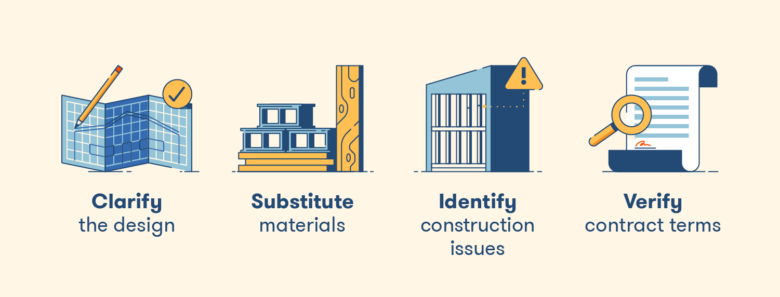Construction projects vary in complexity, and contractors must understand every aspect for efficient project completion. To clear all concerns, contractors use an RFI (Request for Information) document for the stakeholders who have project knowledge.
In this article, you will find how to write an RFI in construction from the sender and replier’s perspective.
For more information on RFIs, check out an informative article written by Bridgit.
What Is RFI in Construction?

Source: sitemate.com
An RFI is a document that contractors usually send to a particular construction project member for clarity. The purpose of an RFI is to help contractors better understand construction phases, including:
- Planning – The RFI document clarifies the planning document to better understand the project.
- Drawing – Contractors send RFI to architects and designers for drawing clarification.
- Scope – Contractors send construction managers an RFI to clear a project scope query.
- Agreement – RFI clarifies gaps in the construction agreement between parties.
Preparing an RFI might look straightforward, but it usually delays the construction, keeping the project behind schedule and exceeding the cost from the allocated budget. The delay of the RFI also causes conflict and legal issues during the project.
That’s why all construction stakeholders must understand how RFI works.
The RFI Lifecycle

Source: viewpoint.com
Usually, contractors or subcontractors generate the RFI document because they are the most active participants at the construction site. They are directly responsible if anything goes wrong in the construction. While making an agreement, contractors agree that they won’t proceed based on intuition. Instead, they are bound to ask for clarification and then proceed.
Here are the steps involved in the RFI lifecycle:
- A subcontractor writes an RFI and sends it to the general contractor.
- The general contractor reviews the RFI. If the document is unclear, they reject the RFI and send it back to the subcontractor.
- If the document is clear, the general contractor sends the RFI to the project manager.
- The project manager reviews the RFI and discusses it with the architect.
- The project manager sends the RFI to a senior engineer or consultant for a response.
- The project manager receives the response, records it, and sends the document to the general contractor.
- The general contractor sends the RFI to the subcontractor.
How to Write a Construction RFI?

Source: archdesk.com
RFI is a two-way process in which a sender, usually a contractor, writes the document. On the other hand, the receiver could be the respective holder according to the information asked. For example, if the contractor wants clarification in the construction blueprint, the RFI will be sent to the design engineer.
Writing an RFI
Include the following components while writing a construction RFI:
- Project title
- Jobsite address
- RFI number (in sequence)
- RFI title
- Add RFI description
- RFI submission date
- Response deadline
- Name and contact information of the respondent
- Description of the query with reference to the construction area
- Space for response
- Attachments (if any)
- Description of attachments
- Change in construction or budget (optional)
Remember that RFI doesn’t have any standard template. However, you can use RFI templates online, which include all the details mentioned above. You only have to fill in those details and send RFI for a quick workflow.
As a sender, you must duly fill in every piece of information and let a second eye check the document. You can also add images or videos in the attachments section.
According to a study, it takes almost 9.7 days for the respondents to reply to an RFI in construction. That’s one of the reasons why construction projects face delays due to RFI. But it’s better to face a delay than chaos because replying to an RFI is a huge responsibility.
Replying an RFI
Writing a reply to a construction RFI needs thorough research and evaluation. Although you only have to fill the empty spaces in the RFI document, the contractor waits for a reply to resume construction.
In 1981, a hotel collapsed in Kansas City due to poor communication related to design changes between the designer and the person responsible for steel fabrication. To communicate such critical tasks, contractors and other project members use RFI to authenticate information.
Importance of RFI in Construction

Source: constructionblog.autodesk.com
RFI documents ensure quality, safety, and liability during construction projects. If you properly manage RFI, you can efficiently complete a project and stay on top of your construction schedule.
Poorly managing an RFI document leads to exceeding construction costs which is a burden for contractors and clients. So, using RFI documents correctly can avoid unnecessary expenses exceeding your budget.
A construction RFI also ensures jobsite safety by providing the contractor with the location’s insights. For example, a contractor with its subcontractors might not know about the electrically charged components at the jobsite in the daylight. That threatens the workers’ lives because they start working without checking those components.
However, you can add information about the electrical components and alert the contractor about the situation before they begin working. You can also inform them to equip the team with the Personal Protective Equipment (PPE) provided by the company.
Types of RFI

Source: bigrentz.com
There are over 15 types of construction RFI. Here are the most common ones:
- Construction coordination – It’s related to construction procedures and resources.
- Design coordination – This RFI communicates between the design and construction teams.
- Timing and phasing – Contractors send this RFI to report delays due to the unavailability of workers or equipment malfunction.
- Design change – Contractors seek design changes during construction to fix an issue.
- Change in method – Contractors inform the manager about changing a construction technique.
- Material change – It’s related to using a different material specified in the planning document.
- Site conditions – Contractors report the difference between the documented jobsite and the actual jobsite condition.
You can create the RFI title on the issue and prepare a different type according to the construction project.
Conclusion
Although there’s no standard for writing an RFI document, you professionally draft it and include all the details. The clearer and more concise your RFI is, the quicker you will receive its response. Use a word processing tool to write a construction RFI and efficiently complete projects without delay.
